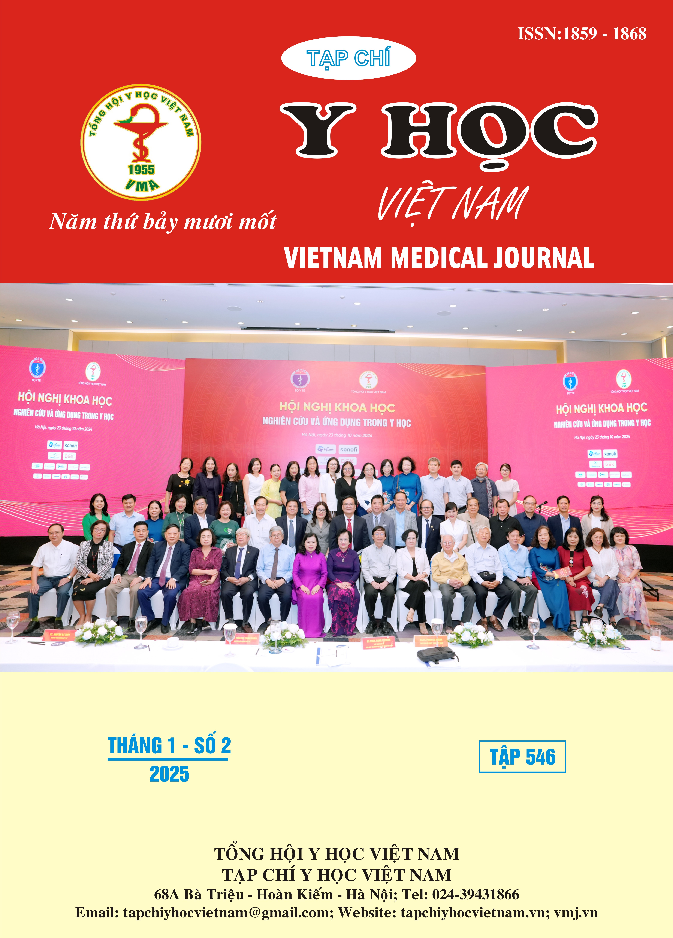EVALUATION OF OUTCOMES FOLLOWING ENDOSCOPIC MEDIAL FLAP INFERIOR TURBINOPLASTY IN THE TREATMENT OF INFERIOR TURBINATE HYPERTROPHY
Main Article Content
Abstract
Objective: To evaluate the outcomes of endoscopic Medial flap Inferior turbinoplasty in the treatment of Inferior turbinate hypertrophy. Subjects and Methods: A clinical trial was conducted on 48 patients aged ≥18 years, suffering from nasal obstruction due to inferior turbinate hypertrophy unresponsive to medical treatment. These patients underwent Endoscopic Medial flap Inferior turbinoplasty at the Department of Surgery and Required Services at 108 Military Central Hospital from August 1, 2023, to July 30, 2024. Effectiveness was assessed based on nasal obstruction evaluation (NOSE score), nasal endoscopy, and Glatzel mirror test score before surgery and at 1 week, 1 month, and 3 months postoperatively. Results: The study included 48 cases (22 males, 26 females) with a mean age of 34.87 ± 8.2 years. The average surgery duration was 14.8 ± 2.30 minutes. Postoperative pain, bleeding, and nasal crusting were minimal. Nasal obstruction improved in 56.25% of patients by the first postoperative week, 70.6% after 1 month, and 91.6% after 3 months, with a statistically significant reduction in NOSE scores (66.8 vs 36.2, P < 0.0001), which was maintained at 1 and 3 months (P < 0.0001). Accompanying symptoms of nasal obstruction—rhinorrhea, sneezing, dry throat, anosmia, and headache—showed statistically significant reductions in both frequency and severity (P < 0.05). The mean postoperative Glatzel mirror test score was 6.93 ± 0.78 cm, ranging from 5 cm to 8 cm. A total of 41/48 patients (81.66%) experienced complete relief from nasal obstruction after surgery. Conclusion: Endoscopic Medial flap Inferior turbinoplasty is a safe and effective method for treating chronic nasal obstruction caused by inferior turbinate hypertrophy
Article Details
Keywords
inferior turbinate hypertrophy, nasal obstruction, Medial flap Inferior turbinoplasty
References
2. Nurse LA, Duncavage JA. Surgery of the inferior and middle turbinates. Otolaryngol Clin North Am. 2009;42(2):295-309, ix.
3. Abdullah B, Singh S. Surgical Interventions for Inferior Turbinate Hypertrophy: A Comprehensive Review of Current Techniques and Technologies. Int J Environ Res Public Health. 2021;18(7):3441
4. Puterman MM, Segal N, Joshua BZ. Endoscopic, assisted, modified turbinoplasty with mucosal flap. J Laryngol Otol. 2012;126(5):525-528.
5. Barham HP, Thornton MA, Knisely A, Marcells GN, Harvey RJ, Sacks R. Long-term outcomes in medial flap inferior turbinoplasty are superior to submucosal electrocautery and submucosal powered turbinate reduction. Int Forum Allergy Rhinol. 2016;6(2):143-147
6. Karamatzanis I, Kosmidou P, Ntarladima V, et al. Inferior Turbinate Hypertrophy: A Comparison of Surgical Techniques. Cureus. 2022;14(12):e32579
7. Dương Minh Ngọc (2023), Tổng quan về phương pháp chỉnh hình cuốn dưới tạo hình vạt. Luận văn thạc sỹ y học, Đại học Y Hà Nội
8. Trần Đình Khả (2006), Điều trị nghẹt mũi do quá phát cuốn dưới bằng đốt điện lưỡng cực dưới niêm mạc, Luận văn tốt nghiệp nội trú. Đại Học Y Dược TP.HCM. tr 33-59
9. Trần Văn Hương và cs (2013), Đánh giá kết quả phẫu thuật giảm thể tích cuốn mũi dưới bằng phương pháp nội soi cắt hút. Y học TP HCM, tập 17, p 60-65.


